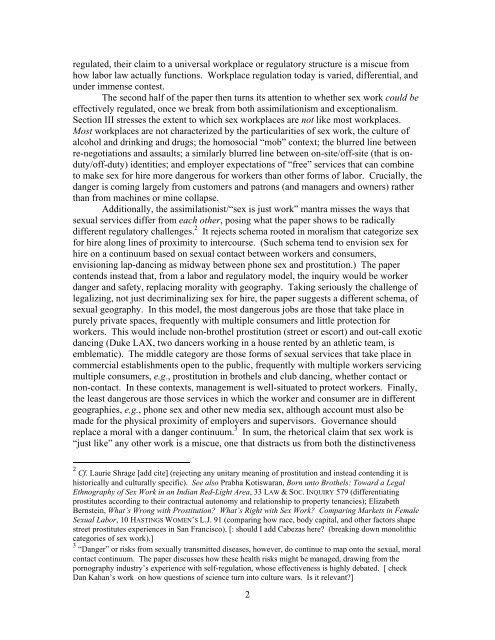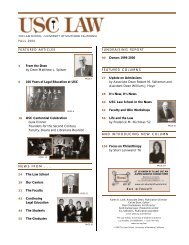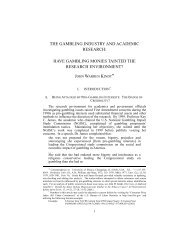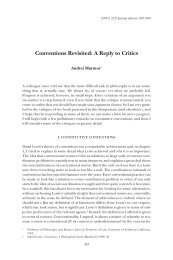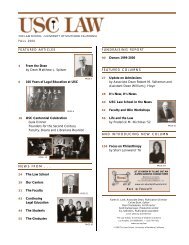1 Regulating Sex Work Adrienne D. Davis VERY ROUGH DRAFT ...
1 Regulating Sex Work Adrienne D. Davis VERY ROUGH DRAFT ...
1 Regulating Sex Work Adrienne D. Davis VERY ROUGH DRAFT ...
You also want an ePaper? Increase the reach of your titles
YUMPU automatically turns print PDFs into web optimized ePapers that Google loves.
egulated, their claim to a universal workplace or regulatory structure is a miscue from<br />
how labor law actually functions. <strong>Work</strong>place regulation today is varied, differential, and<br />
under immense contest.<br />
The second half of the paper then turns its attention to whether sex work could be<br />
effectively regulated, once we break from both assimilationism and exceptionalism.<br />
Section III stresses the extent to which sex workplaces are not like most workplaces.<br />
Most workplaces are not characterized by the particularities of sex work, the culture of<br />
alcohol and drinking and drugs; the homosocial “mob” context; the blurred line between<br />
re-negotiations and assaults; a similarly blurred line between on-site/off-site (that is onduty/off-duty)<br />
identities; and employer expectations of “free” services that can combine<br />
to make sex for hire more dangerous for workers than other forms of labor. Crucially, the<br />
danger is coming largely from customers and patrons (and managers and owners) rather<br />
than from machines or mine collapse.<br />
Additionally, the assimilationist/“sex is just work” mantra misses the ways that<br />
sexual services differ from each other, posing what the paper shows to be radically<br />
different regulatory challenges. 2 It rejects schema rooted in moralism that categorize sex<br />
for hire along lines of proximity to intercourse. (Such schema tend to envision sex for<br />
hire on a continuum based on sexual contact between workers and consumers,<br />
envisioning lap-dancing as midway between phone sex and prostitution.) The paper<br />
contends instead that, from a labor and regulatory model, the inquiry would be worker<br />
danger and safety, replacing morality with geography. Taking seriously the challenge of<br />
legalizing, not just decriminalizing sex for hire, the paper suggests a different schema, of<br />
sexual geography. In this model, the most dangerous jobs are those that take place in<br />
purely private spaces, frequently with multiple consumers and little protection for<br />
workers. This would include non-brothel prostitution (street or escort) and out-call exotic<br />
dancing (Duke LAX, two dancers working in a house rented by an athletic team, is<br />
emblematic). The middle category are those forms of sexual services that take place in<br />
commercial establishments open to the public, frequently with multiple workers servicing<br />
multiple consumers, e.g., prostitution in brothels and club dancing, whether contact or<br />
non-contact. In these contexts, management is well-situated to protect workers. Finally,<br />
the least dangerous are those services in which the worker and consumer are in different<br />
geographies, e.g., phone sex and other new media sex, although account must also be<br />
made for the physical proximity of employers and supervisors. Governance should<br />
replace a moral with a danger continuum. 3 In sum, the rhetorical claim that sex work is<br />
“just like” any other work is a miscue, one that distracts us from both the distinctiveness<br />
2 Cf. Laurie Shrage [add cite] (rejecting any unitary meaning of prostitution and instead contending it is<br />
historically and culturally specific). See also Prabha Kotiswaran, Born unto Brothels: Toward a Legal<br />
Ethnography of <strong>Sex</strong> <strong>Work</strong> in an Indian Red-Light Area, 33 LAW & SOC. INQUIRY 579 (differentiating<br />
prostitutes according to their contractual autonomy and relationship to property tenancies); Elizabeth<br />
Bernstein, What’s Wrong with Prostitution? What’s Right with <strong>Sex</strong> <strong>Work</strong>? Comparing Markets in Female<br />
<strong>Sex</strong>ual Labor, 10 HASTINGS WOMEN’S L.J. 91 (comparing how race, body capital, and other factors shape<br />
street prostitutes experiences in San Francisco). [: should I add Cabezas here? (breaking down monolithic<br />
categories of sex work).]<br />
3 “Danger” or risks from sexually transmitted diseases, however, do continue to map onto the sexual, moral<br />
contact continuum. The paper discusses how these health risks might be managed, drawing from the<br />
pornography industry’s experience with self-regulation, whose effectiveness is highly debated. [ check<br />
Dan Kahan’s work on how questions of science turn into culture wars. Is it relevant?]<br />
2


